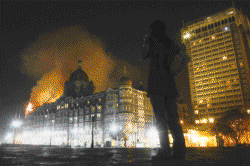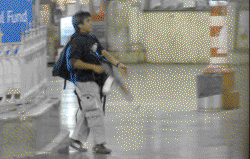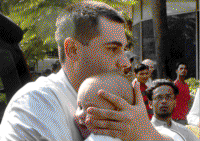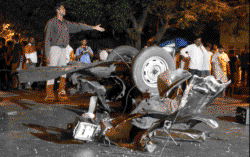Archives
Mayhem in Mumbai
On November 26, 2008, three heavily armed men started firing at the elite restaurant Café Leopold at around 9.30 pm, thus beginning the attacks in Mumbai. After the Leopold massacre, they raided Taj Hotel at 10 PM and opened fire indiscriminately. 
Another group of terrorists, suspected to be four in number, also made simultaneous raids at the Chatrapati Shivaji Terminus (CST) around 10 pm. While two of them started firing at the passengers, the other two moved towards the Metro Cinema. At around 10.15 pm, militants outside the Cama hospital started firing indiscriminately. At 10.30, a taxi exploded in a ball of flame, two persons dying instantaneously in the blast. It is believed that heavy explosives were put inside the taxi. After that, in different places in the metropolis, the terrorists wrought havoc after took control of the Taj Hotel, Trident Hotel and Nariman House which was the headquarters of a Jewish religious group. The militants killed six Jewish people there. 
After the fierce gun-battle carried out at Taj Hotel, Hotel Trident and Nariman House in the very busy Colaba area of Mumbai, the security forces killed all the militants and captured one of them alive. Identified as Ajmal Amir Kasab, a 21-year old from Faridkote district of Pakistan, this ‘Jehadi’ told the police his fellow Pakistani militants intended to strike terror in Mumbai with the intention of killing as many people as possible, cripple the business and inflict injury to the tourism industry of India. Kasab hinted that 39 persons were trained to carry out the destruction in Mumbai, basically to cripple the economy. He also revealed that the Lashkar-e-Taiba had trained all terrorists in marine warfare too at a place in Pakistan named Daura-e-Shifa.
Even as 10 militants have been killed, the Maharashtra Police has intensified a search operation suspecting that there may have been 40 ‘jehadis’ who arrived in Mumbai from Karachi by sea. During interrogation, Kasab has identified his fellow ‘jihadis’ as Abu Ali, Fahad, Omar, Shoaib, Umer, Abu Akasha, Ismail, Abdul Rahman (Bara) and Abdul Rahman (Chhota). All of them are from Pakistan. The needle of suspicion is also pointing to the fact that there might have been some local people or a pro-Pakistan Mumbai based group behind this gory massacre. After arriving in Mumbai, the militants broke up into several groups.
Asked who or which Islamic outfit could be behind this well-planned mayhem, a spokesman of the Maharashtra Police said it is too premature to answer this question but this orchestrated attack must have been carried out at the behest of some Pakistan-based outfit with the active cooperation of ISI. Immediately after the launch of the attack on November 26, 2008, an outfit called Deccan Mujahideen claimed responsibility for it. But nobody has heard of this Islamic body prior to these attacks. The police feel that as the dimension of the attack was very large, it could have been masterminded by the Indian Mujahideen or Lashkar-e-Taiba. While Indian Mujahideen is an offshoot of the Students’ Islamic Movement of India (SIMI), Lashkar-e-Taiba is one of the largest Islamic militant groups in South Asia, based in Pakistan and fighting Indian rule in Kashmir. Police said the Indian Mujahideen may also include former members of Bangladeshi militant group Harkat-ul-Jihad al Islami. The roles of al Qaeda and Pakistan-based ex-Mumbai don Dawood Ibrahim are also not being ruled out.
As the attacks were well coordinated by gunmen on multiple targets, hostages were taken, and foreigners were specifically targeted, the police feel it could be the handiwork of Lashkar-e-Taiba. But the tactic of getting maximum publicity by attacking the prominent targets and the massacring of foreigners show that the attacks could also have been carried out by the al Qaeda. What is most strange is that the militants did not demand anything but wrought havoc clearly indicating that they, all Fidayeens, were aiming at mayhem and panic. One of the militants spoke Urdu with a Kashmiri accent. The Pakistani terrorist Ajmal Amir Kasab told the police that they had been instructed to totally damage Taj Hotel, Trident Hotel and other properties. Belonging to Gipalpura tehsil of Faridkot region of Pakistan, Kasab also told the Mumbai Police during interrogation that he and his 39 colleagues were given the impression that they would come back alive after carrying out their deadly mission in Mumbai.
The attack was totally different from past terror strikes carried out by Islamic terrorists. The attackers struck throughout the city using military tactics. The National Security Guard is particularly concerned about the modus operandi of the Muslim militants who toed the lines of attacks in military style. The planners of the Mumbai attack appear to have chosen able military-aged males. Witnesses have described the men as young and fit. Some of the gunmen appear to have been well trained; some have been credited with having good marksmanship and other military skills.
HOW DID THEY INFILTRATE MUMBAI?
The Maharashtra Deputy Chief Minister, Mr. R.R. Patil has told the media persons that the terrorists infiltrated Mumbai using the sea route from Pakistan. The Indian Navy too has corroborated the fact that the militants came via sea route from Karachi by a ship named MV Alpha. The Indian Navy and Coast Guard pressed two choppers into service and an armed vessel to nab this ship termed as the ‘mother ship’ of the terrorists. Two Pakistani merchant vessels, off the coast of Gujarat, were also zeroed in. Later, the Navy, Coast Guard and the water wing of the Border Security Force (BSF) also captured a boat ‘MV Kuber’, believed to have been captured by the terrorist in Porbaner. The security men also discovered the body of the ship’s captain: killed by the terrorists. Kasab also told the police that his colleagues had slit the throat of the captain open when he objected to their demand of using the vessel to get to Mumbai.
Were the attacks preventable?
According to reports in the Indian media, India had advance knowledge of a likely sea-borne strike on Mumbai on the night of November 26. The Times Now TV news reported that the RAW intercepted a call between India and Lahore on November 19 which indicated that a sea-borne terrorist strike was being planned.
“While November 26 was not mentioned as a precise date, another date before the date of the attack was specified,” the Sunday Express reported. “[The agency] also said the terrorists would probably come by an Indian fishing trawler.”
This information was sent to the Indian navy, coast guard and Maharashtra government. “However, somewhere through the entire process, the seriousness and authenticity of the input were interpreted differently by different agencies. State agencies now claim that such alerts had become a regular feature in recent months.”
This grieve blunder on the part of the authorities is all too common nowadays. One is reminded of the recent serial bomb blasts in Assam where it was reported that the authorities had, as in this case, prior indication of an impending attack but did little to prevent it. One has to wonder if it is complacency on the part of the authorities or just plain nonchalance. Either way, it is the common man, the helpless and the defenseless who has to bear the brunt of these attacks that are now becoming all too frequent. How long must we put up with blunder after blunder. How long can we keep burying our loved ones and resignedly say, “It could have been prevented.”

